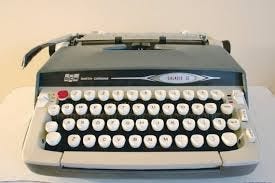In 1957, my Uncle Bob gave me a Smith Corona Galaxie II Manual Typewriter for my twelfth birthday. It was one of the best gifts I've ever received. It was the most loyal, steadfast companion through my years of struggling to write. Always there, no matter what time of day—pre-dawn, mid-day, early afternoon, late night—ready, willing and able. I would open the clunky metal case, and those white keys were poised, at strict attention, as if to say, "Come on! Go ahead, just pound those keys! That’s what I’m made for!"
And pound those keys I did. I type with two fingers, but I type with a vengeance. I type hard. It’s almost as if I'm furious at those keys. I love typing like that, with gusto, and I believe that’s the way manual typewriters are made to be used. When I strike a typewriter key, I feel a link to Gutenberg and his press. The key you strike in turn activates a slim metal arm, the head of which slaps hard against the page. It makes an impression of a single letter, a dark inky impression. The impressions even bleed slightly; they're inky blossoms.
I typed I don’t know how many thousands of pages on my Galaxie II typewriter through the years. I typed the manuscript of my first book, and I remember holding it lovingly before I sent it off to my agent. It was just 100 pages at the time, eventually grew to be 203, but it was all typed, every single letter, every word, slapped on the page by me and my Galaxie II. I typed essays. I typed poems. I typed stories and laments and so many bad pieces of writing, but even bad writing has a kind of basic dignity to it on the typewriter. Try it, if you don’t believe me. This very sentence—written heretically on a computer!—would have a rough, unique elegance if it were typed.
My typewriter stood up astonishingly well under all the irate and passionate pounding I subjected it to. Strong as an ox. Stronger. But once in a while, something happened. The head of an arm just couldn’t take my abuse anymore and gave up the ghost, tumbling off along with the letter it represented. I’ve seen “P” wounded gravely. I’ve seen “S” die. I’ve even seen “!” get very ill. When that happened, I took my Smith Corona to a typewriter repair shop with all the worry and fretfulness of a cat owner bringing his sick pet to the veterinarian. And I had the exact same question asked with the exact same tone, “Can you…make it well?” Luckily, having lived most of my writing life in New York City, there were several reputable and reliable typewriter docs who gave my Galaxie II the expert care it needed.
I kept it for forty good years, until, finally, it collapsed and gave up the ghost. It had gone through many operations, transplants, bypasses, and shunts until its poor body just couldn’t hold up any more. I hardly recognized it at that point, it had so many additions from so many other machines—terminally ill typewriters that had selflessly donated their metal organs so that my typewriter might live. Still, it was a dark day when, with great sadness and solemnity, I let it go. I still think about it, even now.
Smith Corona Galaxie II, thanks for the great ride.



I've used an old manual Smith Corona almost every day since 1992. I remember the day I found it in a hardware store in downtown Nashville. I say "almost" because two months ago, it died. I've felt a bit incomplete ever since. I've used it for letters, first drafts, and problem areas of my writing. The sound of the keys always seems to help push me through the problems. I predict another old one in my future soon!
For that essay, also Stanley Elkin and Richard Ford. Oh, and I shouldn’t forget Danielle Steel.